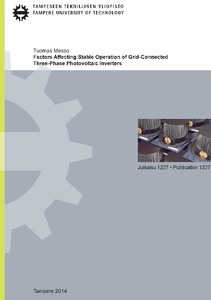Factors Affecting Stable Operation of Grid-Connected Three-Phase Photovoltaic Inverters
Messo, Tuomas (2014)
Messo, Tuomas
Tampere University of Technology
2014
Teknis-taloudellinen tiedekunta - Faculty of Business and Technology Management
This publication is copyrighted. You may download, display and print it for Your own personal use. Commercial use is prohibited.
Julkaisun pysyvä osoite on
https://urn.fi/URN:ISBN:978-952-15-3377-8
https://urn.fi/URN:ISBN:978-952-15-3377-8
Tiivistelmä
The amount of grid-connected photovoltaic energy generation has grown enourmously since the beginning of the 21st century. Photovoltaic power plants are interfaced with the utility grid by using three or single-phase inverters which convert the direct current generated by the photovoltaic modules into three or single-phase alternating current. The photovoltaic inverters have been observed to degrade power quality in the grid and to suffer from reliability problems related to their control software. Therefore, the design of these inverters has become a significant research topic in academia and in the power electronic industry.
Control design of a photovoltaic inverter is often based on the small-signal models characterizing its dynamic behavior. In this thesis, the existing small-signal models are upgraded to include the effect of an upstream DC-DC converter and its control mode. In addition, the models are upgraded to include the effect of a phase-locked-loop which is often used as a synchronization method and the effect of the grid-voltage feedforward which is often used to improve the transient performance.
The control mode of the upstream DC-DC converter is shown to have a significant effect on the minimum DC-link capacitance which is required for stable operation due to a RHP-pole in the inverter control dynamics. However, operating the DC-DC converter under input-voltage control is shown to remove the RHP-pole and, consequently, the constraint imposed on the size of the minimum DC-link capacitance.
The phase-locked-loop (PLL) is shown to make the q-component of the inverter’s output impedance resemble a negative resistor. Based on the small-signal models, the negative resistance is shown to appear at the frequencies below the crossover frequency of the PLL. Therefore, a wide-bandwidth PLL causes easily instability due to the negative-resistance behavior when the grid inductance is large.
The grid-voltage feedforward is shown to increase the magnitude of both the d and q-components of the inverter’s output impedance. The PV inverter with grid-voltage feedforward is shown to be more resistant against impedance-based interactions than an inverter without the feedforward.
Control design of a photovoltaic inverter is often based on the small-signal models characterizing its dynamic behavior. In this thesis, the existing small-signal models are upgraded to include the effect of an upstream DC-DC converter and its control mode. In addition, the models are upgraded to include the effect of a phase-locked-loop which is often used as a synchronization method and the effect of the grid-voltage feedforward which is often used to improve the transient performance.
The control mode of the upstream DC-DC converter is shown to have a significant effect on the minimum DC-link capacitance which is required for stable operation due to a RHP-pole in the inverter control dynamics. However, operating the DC-DC converter under input-voltage control is shown to remove the RHP-pole and, consequently, the constraint imposed on the size of the minimum DC-link capacitance.
The phase-locked-loop (PLL) is shown to make the q-component of the inverter’s output impedance resemble a negative resistor. Based on the small-signal models, the negative resistance is shown to appear at the frequencies below the crossover frequency of the PLL. Therefore, a wide-bandwidth PLL causes easily instability due to the negative-resistance behavior when the grid inductance is large.
The grid-voltage feedforward is shown to increase the magnitude of both the d and q-components of the inverter’s output impedance. The PV inverter with grid-voltage feedforward is shown to be more resistant against impedance-based interactions than an inverter without the feedforward.
Kokoelmat
- Väitöskirjat [4769]
